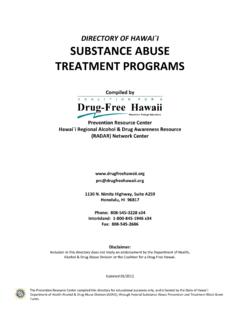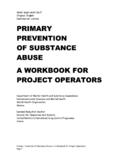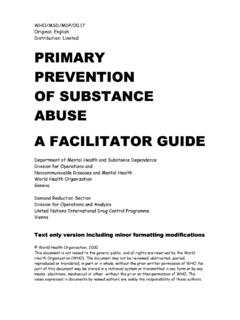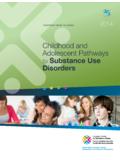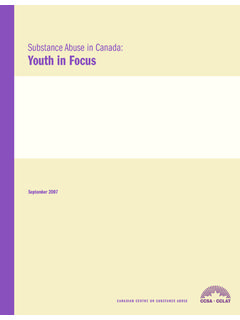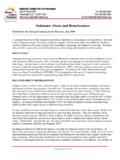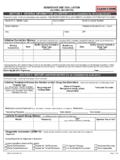Transcription of Substance Abuse and Dependence
1 CHAPTERS ubstance Abuse and DependenceCHAPTER OUTLINECLASSIFICATION OF Substance -RELATEDDISORDERS 291 296 Substance Abuse and DependenceAddiction and Other Forms of CompulsiveBehaviorRacial and Ethnic Differences in SubstanceUse DisordersPathways to Drug DependenceDRUGS OF Abuse 296 310 DepressantsStimulantsHallucinogensReside ntial ApproachesPsychodynamic ApproachesBehavioral ApproachesRelapse-Prevention TrainingSUMMING UP 325 326 THEORETICAL PERSPECTIVES 310 316 Biological PerspectivesLearning PerspectivesCognitive PerspectivesPsychodynamic PerspectivesSociocultural PerspectivesTREATMENT OF Substance Abuse AND Dependence 316 325 Biological ApproachesCulturally Sensitive Treatment of AlcoholismNonprofessional Support Groups9291orT F Heroin accounts for more deathsthan any other drug. (p. 291)T F You cannot be psychologicallydependent on a drug without also beingphysically dependent on it.
2 (p. 295)T F More teenagers and young adults diefrom alcohol-related motor vehicle accidentsthan from any other cause. (p. 297)T F It is safe to let someone who haspassed out from drinking just sleep it off. (p. 301)T F Even moderate use of alcoholincreases the risk of heart attacks. (p. 303)T F Coca-Cola originally containedcocaine. (p. 306)T F Breast cancer is the leading cause ofcancer deaths among women. (p. 307)T F People who can hold their liquor better than most stand a lower risk ofbecoming problem drinkers. (p. 312)T F A widely used treatment for heroinaddiction involves substituting anotheraddictive drug. (p. 318)or Nothing and Nobody Comes Before My Coke She had just caught me with cocaine again after I had managed to convince her thatI hadn t used in over a month. Of course I had been tooting (snorting) almost everyday, but I had managed to cover my tracks a little better than usual.
3 So she said tome that I was going to have to make a choice either cocaine or her. Before shefinished the sentence, I knew what was coming, so I told her to think carefully aboutwhat she was going to say. It was clear to me that there wasn t a choice. I love mywife, but I m not going to choose anything over cocaine. It s sick, but that s whatthings have come to. Nothing and nobody comes before my coke. From Weiss & Mirin,1987, p. 55 THESE COMMENTS FROM EUGENE,A41-YEAR-OLD ARCHITECT,UNDERSCORE THE POWERFUL effects that drugs like cocaine can have on people s lives. Our society is flooded withpsychoactive substances that alter the mood and twist perceptions substances thatlift you up, calm you down, and turn you upside down. Many young people start usingthese substances because of peer pressure or because their parents and other authorityfigures tell them not to.
4 For Eugene, as for many others who become addicted to drugs,the pursuit and use of drugs takes center stage in their lives and becomes even moreimportant than family, work, or their own this chapter we examine the physiological and psychological effects of the majorclasses of drugs. We explore how mental health professionals classify Substance -relateddisorders and where we draw the line between use and Abuse . We then examine con-temporary understandings of the origins of these disorders and how mental healthprofessionals help people who struggle to combat OF Substance -RELATED DISORDERSU nder certain conditions, the use of substances that affect mood and behavior is normal,at least as gauged by statistical frequency and social standards. It is normal to start theday with caffeine in the form of coffee or tea, to take wine or coffee with meals, to meetfriends for a drink after work, and to end the day with a nightcap.
5 Many of us take pre-scription drugs that calm us down or ease our pain. Flooding the bloodstream withnicotine by means of smoking is normal in the sense that about 1 in 5 Americans do , some psychoactive substances, such as cocaine, marijuana, and heroin, are ille-gal and are used illicitly. Others, such as antianxiety drugs (such as Valium and Xanax)and amphetamines (such as Ritalin), are available by prescription for legitimate medicaluses. Still others, such as tobacco (which contains nicotine, a mild stimulant) and alco-hol (a depressant), are available without prescription, or over-the-counter. Ironically, themost widely and easily accessible substances tobacco and alcohol cause more deathsthrough sickness and accidents than all illicit drugs classification of Substance -related disorders in the DSMsystem is not based onwhether a drug is legal or not, but rather on how drug use impairs the person s physio-logical and psychological functioning.
6 The DSM-IVclassifies Substance -related disordersinto two major categories: Substance use disorders and Substance -induced disordersare disorders induced by using psychoactive substances,such as intoxication, withdrawal syndromes, mood disorders, delirium, dementia, amne-sia, psychotic disorders, anxiety disorders, sexual dysfunctions, and sleep substances have different effects, so some of these disorders may be induced byone, a few, or nearly all substances. Let us consider the example of accounts for more deaths than any otherdrug. legally available substances,alcohol and tobacco, cause far more deaths. FICTIONTRUTH orsubstance-induced disordersDisorders,such as intoxication, that can be induced byusing psychoactive 9 Two of the many faces of alcohol use and is our most widely used andabused drug. Many people use alcohol to celebrate achievements and happy occasions, as inthe photograph on the left.
7 Unfortunately, like the man in the photograph on the right, somepeople use alcohol to drown their sorrows, which may only compound their problems. Whereexactly does Substance use end and Abuse begin? According to the DSM,use becomes abusewhen it leads to damaging state of use disordersDisorders chararacterized by maladaptive use of psychoactive substances ( , substancedependence). Substance abuseThe continued use of apsychoactive drug despite the knowledgethat it is causing a social, occupational, psychological, or physical dependenceImpaired controlover the use of a psychoactive Substance ; oftencharacterized by physiological intoxicationrefers to a state of drunkenness or being high. This effectlargely reflects the chemical actions of the psychoactive substances. The particular fea-tures of intoxication depend on which drug is ingested, the dose, the user s biologicalreactivity, and to some degree the user s expectations.
8 Signs of intoxication ofteninclude confusion, belligerence, impaired judgment, inattention, and impaired motorand spatial skills. Extreme intoxication from use of alcohol, cocaine, opioids, (nar-cotics) and PCP can even result in death (yes, you can die from alcohol overdoses),either because of the Substance s biochemical effects or because of behavior patterns such as suicide that are connected with psychological pain or impaired judgmentbrought on by use of the use disordersare patterns of maladaptive use of psychoactive sub-stances. These disorders, which include Substance abuseand Substance Dependence ,arethe major focus of our Abuse and DependenceWhere does Substance use end and Abuse begin? According to the DSM,substanceabuseis a pattern of recurrent use that leads to damaging consequences. Damagingconsequences may involve failure to meet one s major role responsibilities ( , as stu-dent, worker, or parent), putting oneself in situations where Substance use is physicallydangerous ( , mixing driving and Substance use), encountering repeated problemswith the law arising from Substance use ( , multiple arrests for Substance -relatedbehavior), or having recurring social or interpersonal problems because of substanceuse ( , repeatedly getting into fights when drinking).
9 When people repeatedly miss school or work because they are drunk or sleeping itoff, their behavior may fit the definition of Substance Abuse . A single incident of exces-sive drinking at a friend s wedding would not qualify. Nor would regular consumptionof low to moderate amounts of alcohol be considered abusive so long as it is not con-nected with any impairment in functioning. Neither the amount nor the type of drugingested, nor whether the drug is illicit, is the key to defining Substance Abuse accord-ing to the , the determining feature of Substance Abuse is whether a pat-tern of drug-using behavior becomes repeatedly linked to damaging Abuse may continue for a long period of time or progress to substancedependence,a more severe disorder associated with physiological signs of Dependence (tolerance or withdrawal syndrome) orcompulsive use of a Substance . People whoSubstance Abuse and Dependence293tolerancePhysical habituation to a drugsuch that with frequent use, higher doses areneeded to achieve the same syndromeA characteristiccluster of symptoms following the suddenreduction or cessation of use of a psychoactivesubstance after physiological Dependence compulsive users lack control over their drug use.
10 They may be aware of howtheir drug use is disrupting their lives or damaging their health, but feel helpless orpowerless to stop using drugs, even though they may want to. By the time they becomedependent on a given drug, they ve given over much of their lives to obtaining andusing it. The cocaine user whose words opened this chapter would certainly fit this def-inition. The diagnostic features of Substance Dependence are listed in Table use of a Substance may alter the body s physiological reactions, leading tothe development of tolerance or a physical withdrawal syndrome (see Table ).Toleranceis a state of physical habituation to a drug, resulting from frequent use, suchthat higher doses are needed to achieve the same effect. A withdrawal syndrome(alsocalled an abstinence syndrome) is a cluster of symptoms that occur when a dependentperson abruptly stops using a particular Substance following heavy, prolonged who experience a withdrawal syndrome often return to using the Substance torelieve the discomfort associated with withdrawal, which thus serves to maintain theaddictive pattern.










